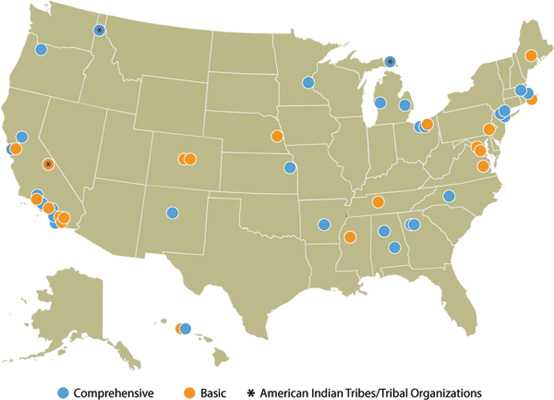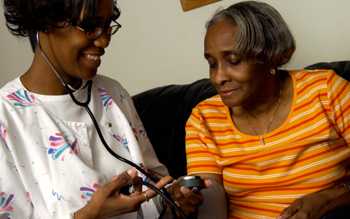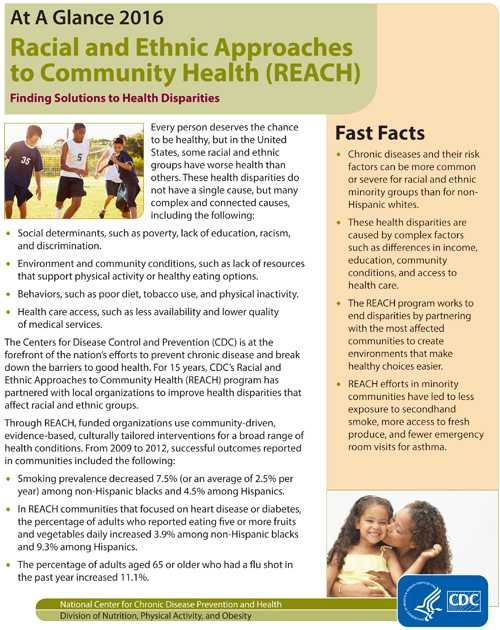Racial and Ethnic Approaches to Community Health (REACH)
Finding Solutions to Health Disparities
At A Glance 2016
Every person deserves the chance to be healthy, but in the United States, some racial and ethnic groups have worse health than others. These health disparities do not have a single cause, but many complex and connected causes, including the following:
- Social determinants, such as poverty, lack of education, racism, and discrimination.
- Environment and community conditions, such as lack of resources that support physical activity or healthy eating options.
- Behaviors, such as poor diet, tobacco use, and physical inactivity.
- Health care access, such as less availability and lower quality of medical services.
The Centers for Disease Control and Prevention (CDC) is at the forefront of the nation’s efforts to prevent chronic disease and break down the barriers to good health. For 15 years, CDC’s Racial and Ethnic Approaches to Community Health (REACH) program has partnered with local organizations to improve health disparities that affect racial and ethnic groups.
Through REACH, funded organizations use community-driven, evidence-based, culturally tailored interventions for a broad range of health conditions. From 2009 to 2012, successful outcomes reported in communities included the following:
- Smoking prevalence decreased 7.5% (or an average of 2.5% per year) among non-Hispanic blacks and 4.5% among Hispanics.
- In REACH communities that focused on heart disease or diabetes, the percentage of adults who reported eating five or more fruits and vegetables daily increased 3.9% among non-Hispanic blacks and 9.3% among Hispanics.
- The percentage of adults aged 65 or older who had a flu shot in the past year increased 11.1%.
Public Health Problem
Heart disease, cancer, diabetes, and stroke are among the most common causes of illness, disability, and death in the United States. These chronic conditions—and the factors that lead to them—can be more common or severe for minority groups (specifically, non-Hispanic blacks, Hispanics, American Indians, Alaska Natives, Asians, Native Hawaiians, and Pacific Islanders). For example:
- Non-Hispanic blacks are 40% more likely than non-Hispanic whites to have high blood pressure, and they are less likely to have this condition under control.
- The rate of diagnosed diabetes is 77% higher among non-Hispanic blacks, 66% higher among Hispanics, and 18% higher among Asians than among non-Hispanic whites.
- American Indians and Alaska Natives are 60% more likely to be obese than non-Hispanic whites.
- Life expectancy for non-Hispanic blacks is 75.1 years, compared to 78.9 years for non-Hispanic whites.
Related Materials
Fast Facts
- Chronic diseases and their risk factors can be more common or severe for racial and ethnic minority groups than for non-Hispanic whites.
- These health disparities are caused by complex factors such as differences in income, education, community conditions, and access to health care.
- The REACH program works to end disparities by partnering with the most affected communities to create environments that make healthy choices easier.
- REACH efforts in minority communities have led to less exposure to secondhand smoke, more access to fresh produce, and fewer emergency room visits for asthma.
Racial and ethnic minority populations often receive poorer quality of care and face more barriers in seeking care, including preventive care and chronic disease management, than do non-Hispanic whites. These disparities can lead to poor health outcomes and higher health care costs.
Translating REACH Success
REACH awardees are leaders in confronting racial and ethnic disparities—and sharing their successes to improve the health and wellness of other communities.
- In Seattle/King County, Washington, REACH partners created a train-the-trainer model of their effective diabetes management curriculum so that other community organizations could use it for the same populations.
- Efforts by the Community Health Councils of Los Angeles have improved access to healthy foods in South Los Angeles. Successful programs include the California FreshWorks Fund, which helps build grocery stores in food deserts.
- In 2006, New York City, the largest school district in the country, eliminated whole milk and reduced the availability of sweetened milk in 1,579 schools. This change was due in part to efforts by the Bronx Health REACH coalition to change the school environment in the Bronx.

REACH Awardees, Fiscal Year 2014
(as of June 2015)

Note: Basic Implementation awardees address at least one chronic disease risk factor. Comprehensive Implementation awardees address at least two chronic disease risk factors.
Source: REACH website.
CDC’s Response
The National Center for Chronic Disease Prevention and Health Promotion (NCCDPHP) works in four key areas or domains: epidemiology and surveillance, environmental approaches, health care system interventions, and community programs linked to clinical services. This comprehensive approach supports healthy choices and behaviors, makes healthier options more available, and helps Americans better manage their health.
CDC works with partners—such as public health agencies, other federal agencies, academia, and community organizations—to improve the health of racial and ethnic minority groups. With $50.9 million in FY 2015 funding, CDC’s REACH program supports these efforts by focusing on activities in three of NCCDPHP’s four domains: environmental approaches, health care system interventions, and community programs linked to clinical services.
Environmental Approaches
CDC uses environmental approaches that encourage healthy behaviors in various settings, including schools, worksites, and health care facilities. REACH activities expand access to healthy food and beverages, promote increased physical activity, reduce tobacco use and prevent youth initiation, and eliminate exposure to secondhand smoke.
Improving Access to Healthy Food
The University of Illinois at Chicago supported the Food Desert Action/Fresh Moves Mobile Produce Market (FMMPM) to improve access to affordable fresh fruits and vegetables for low-income residents of the Austin and North Lawndale neighborhoods. Healthy food was not available or easily accessible in these neighborhoods. Residents can now buy fresh fruits and vegetables 4 days a week from a mobile food market that also accepts federal food assistance benefits. Since 2011, FMMPM has sold more than 20,000 pounds of fruits and vegetables and helped more than 8,400 residents.
CDC’s Twin Approach
CDC’s Twin Approach applies both populationwide and culturally tailored interventions at the same time. The following hypothetical examples show how the Twin Approach could be used to address health disparities:
- Protecting residents of multiunit housing from secondhand smoke exposure by (1) educating everyone about the benefits of smoke-free housing and cessation services and (2) offering free or low-cost cessation services to residents in low-income housing.
- Improving community access to healthy food and beverages by (1) working to improve public transit to healthy food retail outlets and (2) tailoring messages about new or expanded transit options to the community members who depend on public transport.
Preventing Obesity and Secondhand Smoke Exposure
Through previous CDC REACH funding, the University of Alabama at Birmingham (UAB) reduced poor health outcomes among non-Hispanic blacks by leveraging the work of prior community health programs. Those programs were aimed at reducing secondhand smoke exposure at work, creating a trail system for physical activity, developing child care guidelines for obesity prevention, and implementing school wellness policies to improve nutrition and physical activity. REACH 2014 funding will allow UAB to continue to engage its coalition of more than 100 members to increase access to nutritious foods and physical activity opportunities for non-Hispanic blacks in Birmingham.
Health Care System Interventions
CDC supports health system interventions to improve the delivery and use of clinical and other preventive services. REACH funds awardees to increase access to high-quality health services, use health information technology and tools (e.g., reminders, clinical decision support), and deliver quality care to hard-to-reach populations.
Increasing Access to Preventive Health Care Services
The Boston Children’s Hospital Community Asthma Initiative led a 5-year comprehensive case management program that provided better access to health care services for low-income non-Hispanic black and Hispanic children with asthma. The program led to 80% fewer hospitalizations, 56% fewer emergency department visits, and 41% fewer missed school days for these children. The avoided treatment costs yielded a $1.46 return on every $1 invested in the program.

Community Programs Linked to Clinical Services
REACH awardees participate on multidisciplinary teams to help patients manage chronic diseases. These teams may include allied health providers (e.g., nurses, dentists), community health workers, and patient navigators who support control of blood pressure, cholesterol, and blood sugar levels.
Increasing Health Education Access
The Colorado Black Health Collaborative, Inc. (CBHC) will collaborate with a network of public and private clinicians and the community to conduct trainings and increase access to health education resources. CBHC and its partners will also work to improve links to clinical and community services that help prevent and manage chronic conditions.
Future Directions
CDC’s REACH program will continue to build on a body of knowledge established through previous investments to reach minority populations with the greatest health needs.
Through the REACH program, funded communities will be empowered to create long-term, sustainable health solutions that break down barriers to health.
Continued REACH investments will focus on strengthening community health efforts that prevent disease and reduce racial and ethnic health disparities. These investments will allow REACH programs to help CDC meet the long-term goals established in its FY 2014 funding awards for chronic disease, which are to:
- Reduce the rates of death and disability due to tobacco use by 5%.
- Reduce the prevalence of obesity by 3%.
- Reduce the rates of death and disability due to diabetes, heart disease, and stroke by 3%.
- Page last reviewed: November 29, 2016
- Page last updated: November 29, 2016
- Content source:



 ShareCompartir
ShareCompartir
